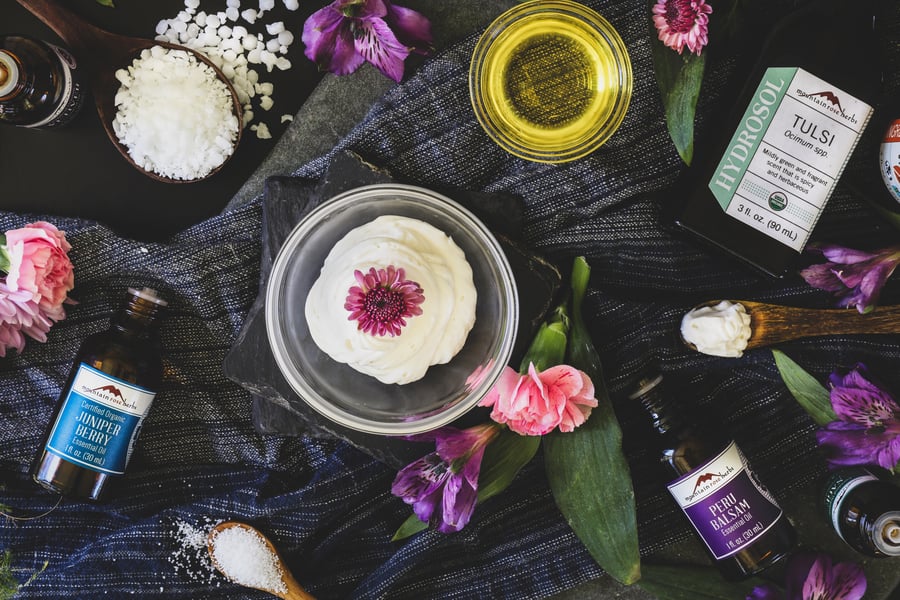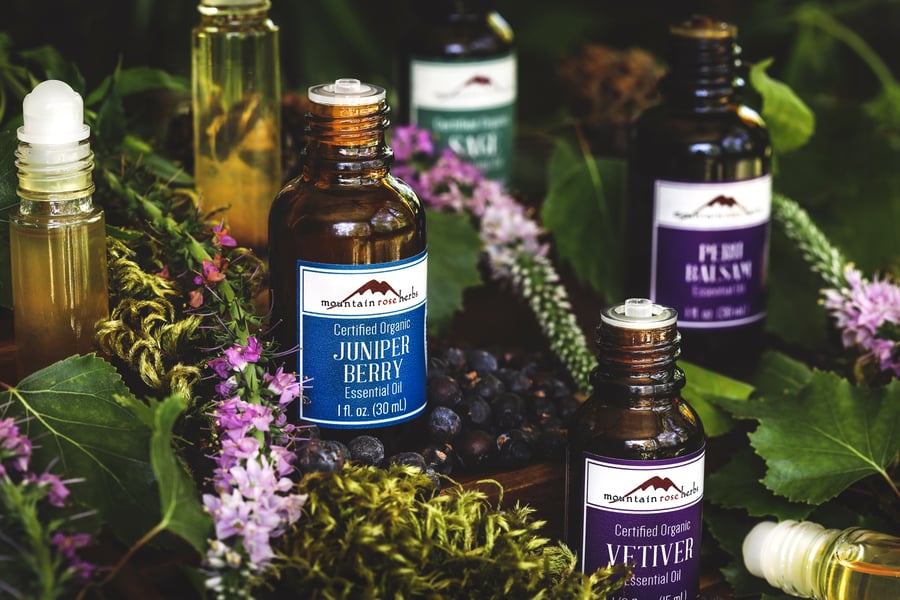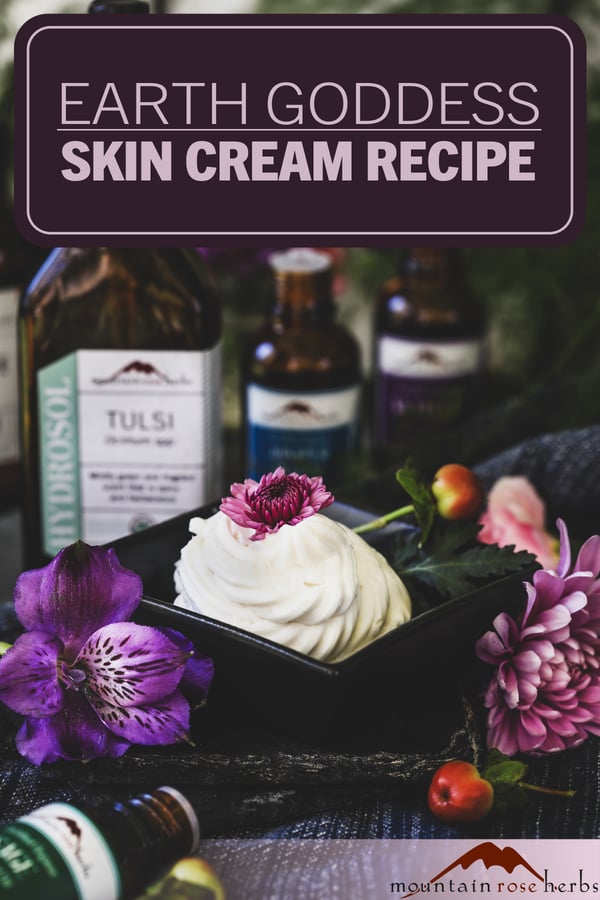I love the shoulder seasons—spring and fall, planting and harvest—because they connect me deeply to the earth. This year, I wanted to celebrate that connection with an aroma change-up to my usual body lotion recipe. I tend to be a keep-it-simple sort of woman when using essential oils in skin- and haircare recipes. For my purposes, I usually reach for lavender and call it good. So, to create the earthy, fertile aroma I wanted this season, I turned to an essential oil blend formulated by someone with more expertise in blending aromas: Mountain Rose Herbs’ marketing lead, Jessicka. I combined my tried-and-true lotion recipe with her Earth Goddess perfume essential oil blend. The result is luscious and season-perfect!
When you convert one part of a recipe to use in another formulation, it’s helpful to have a working relationship with measuring in parts. In this case, the perfume includes 21 drops of the essential oil blend to go in a 10 mL roll-top bottle, whereas the lotion recipe needs 1/2-1 teaspoon of the oil blend with the correct proportions of each essential oil to capture the same aroma. The easiest way to make that conversion is measuring in parts.
How to Convert the Essential Oil Blend
Earth Goddess Perfume Blend includes ten drops of vetiver essential oil, five drops of juniper berry essential oil, four drops of Peru balsam essential oil, and two drops of sage essential oil. If we look at those proportions, we can find the least common denominator (two drops) and call it one part.
With this determined, we can now say our lotion aroma blend needs to be:
- 1 part sage essential oil
- 2 parts Peru balsam essential oil
- 2 1/2 parts juniper berry essential oil
- 5 parts vetiver essential oil
For easy measuring, I rounded the 2 1/2 parts juniper berry oil down to 2 parts (equal parts Peru balsam and juniper berry). With that slight change, we now have ten parts, which is easy to work with, and we know vetiver makes up half of the blend (5 parts). From here, it’s straightforward.
We know we need 1/2-1 teaspoon of essential oils in the base lotion recipe, and by looking at Mountain Rose Herbs’ handy essential oil conversion chart, we find that equals 50-100 drops (50 equaling 1% dilution and 100 equaling 2%). So we can now calculate how much we need for each oil in drops to total either 50 or 100. Since we already know that the vetiver essential oil will make up half of the drops, we divide the remaining half by the number of remaining parts (five) to find how many drops equals one part and then multiply accordingly.
How does rounding down an oil change the aroma of the blend?
If you’ve done the math, 1/2-part equals 5-10 drops in this lotion recipe, which is fairly significant when working with essential oils. By balancing the amount of Peru balsam and juniper berry, we keep the delicious balsamic aroma of both and highlight more of the vanilla-like undertones of the Peru balsam oil.
With its mildly spicy, sweet, and herbaceous scent, tulsi hydrosol makes a wonderful base for this less-juniper blend. Plus, it is probably my all-time favorite hydrosol, so there’s that.
Earth Goddess Homemade Lotion Recipe
Makes about 1 1/2 cups.
Use the smaller number of drops to create a milder 1% aroma for your lotion. Use the larger amount for a more aromatic lotion with 2% essential oils. Also, the essential oils are technically optional. This lotion is subtly divine just using luscious tulsi hydrosol.
Ingredients
- 25-50 drops organic vetiver essential oil
- 10-20 drops organic Peru balsam essential oil
- 10-20 drops organic juniper berry essential oil
- 5-10 drops organic sage essential oil
- 2/3 cup organic tulsi hydrosol
- 3 Tbsp. organic jojoba oil or refined sweet almond oil
- 1 Tbsp. organic refined shea butter
- 4 tsp. emulsifying wax
- 4 tsp. stearic acid
- 1 1/2 tsp. organic vegetable glycerine
- 1/8 tsp. non-GMO citric acid (optional, but it ensures a proper pH)
- 1/2 tsp. non-GMO vitamin E oil
Directions
- Combine essential oils in a bottle with an airtight lid and shake to combine. Set aside.
- Arrange a double boiler with several inches of water in the bottom. Set over medium heat.
- Combine tulsi hydrosol, oil of choice, shea butter, emulsifying wax, stearic acid, vegetable glycerine, and citric acid in the top of the double boiler.
- Heat the hydrosol mixture to about 170°F, stirring regularly with a rubber spatula, whisk, or another non-reactive tool, until everything is completely melted and combined. You want to ensure there are no remaining bits of wax, etc. Do not let the mixture come to a boil!
- When everything is melted and incorporated, pour into a medium bowl and cool to about 160°F.
- Use an immersion blender or hand mixer at approximately medium speed to blend (they are all different, so adjust speed as necessary for your model). Make sure the beater is submerged as deeply as possible in the mixture so you don’t create a lot of bubbles and foam. Blend for 1-2 minutes. Then use a clean rubber spatula or wooden spoon to vigorously stir down any resulting bubbles or foam and reincorporate them into the mix. Scrape down the sides.
- Test the temperature of your mix. When it has cooled to about 110°F, add vitamin E oil and the essential oil blend.
- Use the immersion blender again fully submerged for another minute or two. Repeat the stirring-down process with the spatula or spoon, and the immersion blender and hand-stirring as necessary to achieve a thickened lotion consistency. This takes about 5 minutes. You should be able to lift the blender or spoon and the lotion will fold over and leave a track (as opposed to being so liquid that it reincorporates smoothly into the lotion), but it should not be so thick that you can create peaks. It will thicken more as it cools.
- Pour your lotion back-stock into a sterile container with an airtight lid, label it with the name of the lotion and the date made, and store in refrigerator. Take out only as much lotion as you will use in the next week and put into a small, sterile bottle with a pump top. Label, and store in a cool place away from direct light and heat fluctuations for easy day-to-day use. Always store the rest in the refrigerator. If properly made and stored, the back-stock will last 3-4 months.
Pro Tips
- You can use distilled water in place of the hydrosol. Depending on your water, using tap water can throw off the pH in lotions, so I always stick with distilled water.
- Using olive oil or avocado oil in place of almond or jojoba oil will give your lotion a heavier, more hydrating body.
- Want to add a little more juniper berry to match the original perfume blend? Subtract up to 5 drops of Peru balsam oil and replace them with juniper berry essential oil.
Want to convert this recipe for other seasons?
Try it with a Warming Fall Spice Blend!
You may also enjoy:
- Homemade Lotion with Organic Sweetgrass Hydrosol
- Triple Rose Moisturizing Face Cream Recipe
- DIY Toning Coffee Body Butter













